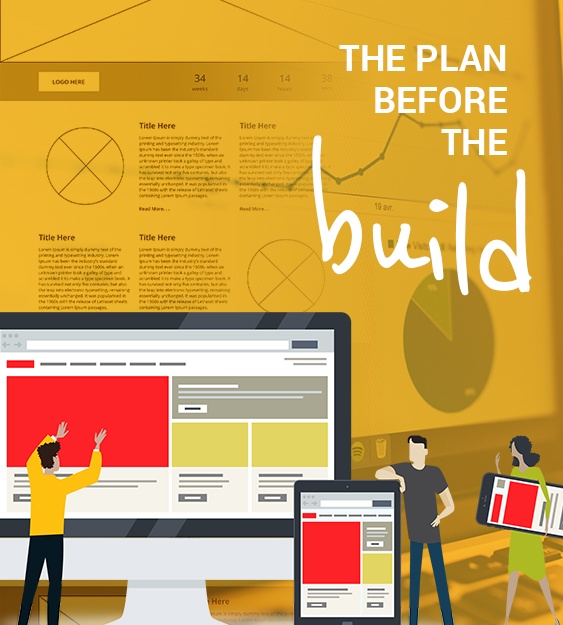Digital (app & website) design and development goes above and beyond just coding.
Know This: Without Architecture, Web Design is Obsolete
Have you ever thought about how buildings are made? Of course, to create such significant buildings, one needs the expertise and guidance of the discipline of architecture. Architecture allows professionals to create the most magnificent work possible. But to build these structures, one needs an extraordinary amount of planning. With architecture, planning is everything where no detail ever goes unnoticed. The development process involves creating blueprints, mock-ups, and building models, to name a few. There are other aspects of architecture that are considered before even laying the concrete for the foundation.
That’s how essential it is to get everything right before the actual construction starts. The same can be said for web design. Web design goes above and beyond just coding. For web design, we take some principles of architecture (including form meeting function) and incorporate them when constructing a website. It’s honestly no different from traditional architecture because, from our perspective, web design is another form of architecture. We need architecture elements to produce a functional and efficient website because, without such vital discipline, web design serves no purpose; it just becomes obsolete. Throughout this article, we will discuss some of the most important components of developing a beautiful yet functional website. It takes an entire process before a website goes live. Let us provide you a brief insight on how a website comes to life.
What is the Web Development Process?
One of the best ways to get quick and factual information about a company people are interested in doing business with is to see if they have a website. When prospective customers interact with a website first-hand, they may experience various emotions. They can either be thrilled to see a website with all the relevant information and see that the website itself is neat, organized, and user-friendly. On the other hand, some customers may encounter a website that includes all pertinent information, but the website itself is cluttered and disorganized. Even if the website has all of the information necessary, if the website is not user-friendly and does not inspire customers to look for the information necessary to obtain a service or purchase a product, companies can just say “Sayonara” to these customers – for good. For companies to avoid this situation, a structured web development process is needed to ensure their websites are user-friendly.
The web development process outlines steps required to create a website and ensure the website development project is successful. Planning is key. We cannot stress this enough. As the saying goes, when you fail to prepare, prepare to fail. Preparation is essential to ensure organizations have the best website possible to maximize marketing efforts and access potential customers. In today’s technology-driven environment, a website is a must-have to compete. Brands must avoid common mistakes found on websites. One of the best ways to avoid them is by ensuring a thorough web development process with all the necessary steps to build brand awareness, connect with target audiences, and reach organizational goals.
B.ID Design Process, From Inception to Launch
Without further ado, we would like to introduce b.iD’s website design and development process. It has taken a considerable amount of time to perfect, but we are proud of the results it yields for our clients.
1) Planning
In our process, there are so many components that make up our planning phase. First, we incorporate fact gathering as well as developing sitemaps and wireframes. That is because to develop sitemaps and wireframes; all relevant information must be gathered. What is this information, you may ask? We typically ask clients questions that help us determine all pertinent facts. These include asking clients about the goals they have in mind for their website and its purpose, for example, if they want to provide general information or promote and sell a product/service. We also research the client and determine target audiences based on multiple demographic factors.
All of this data helps us determine the appropriate actions and provide us with authority to create an initial visual layout for the website, such as wireframes. Another element that helps us develop wireframes includes a sitemap. A sitemap serves as a blueprint that includes all potential pages of a website and their relation to each other. The planning phase is deemed successful when we develop a visual layout that meets the needs of our client and their audience. The visual layout helps us determine the hierarchy of elements that we will prioritize in the final version of a website.
2) Conversion Strategy
It’s never too early to start thinking about a conversion strategy. After all, a website without a reliable strategy to attract customers will not serve its purpose. After wireframes and other mock-ups are developed, we can see the bigger picture that helps us determine how to produce an effective conversion strategy. During this phase, we start to connect the dots, slowly and methodically, to ensure that we can help clients achieve desired outcomes. A conversion strategy helps us look into the future and avoid some common pitfalls associated with a poorly developed website. Because we have been able to develop the target or ideal customer in the planning phase, we can begin producing a conversion strategy.
Other important elements that must be factored into creating a successful conversion strategy include identifying unique selling points or propositions, establishing key performance indicators, and determining potential roadblocks that get in the way of converting new customers as well as other factors that help us with developing the best conversion strategy for the needs of a particular business. The endgame is to develop relationships with customers to ensure they stay long-term patrons of a particular business. We understand that the success of any business depends on how well they are able to develop relationships with customers/clients. The best-designed website can be produced, but long-term relationships are less likely to be produced without an effective conversion strategy. This can have long-term consequences for your business.
3) Design
This is an exciting phase of the web development process. Through the information, data, and other relevant facts gathered, we can begin the design process. This phase includes incorporating some of the visual elements developed through the help of sitemaps and wireframes. No mock-ups here. This is where some of the most exciting visual components are created. Everything starts taking shape. This phase allows us to create impactful visual content, including adding images, videos, photos, as well as creating the perfect design layout. We are also able to produce a visual theme that helps us determine which color scheme to utilize and other graphic elements.
All of these components bring to life a website and allow us to develop the vision that our clients have in mind. It is also the step in which our clients can have more of a say and an impact on the website’s design. We communicate back and forth with our clients to determine which edits to make in the website’s layout, which ensures that our clients are always included in the development process. To put it simply, we want to make sure that our clients and b.iD are on the same page regarding the vision in mind for the website.
4) Content Creation
Some may believe this is a boring part of website development. This couldn’t be further from the truth. One of the best ways to ensure you are fulfilling the purpose of your website, that is, to attract more and convert more customers, is to make certain that the website copy is up to par. Great content can impact. It can inspire audiences to make certain actions. It makes a prospective client become a long-term client. Powerful content can help build relationships, ensuring long-term success for your business. This is what we tell our clients. Never disregard content. Websites are all about brand awareness, and the right copy can elevate your brand to new heights and ensure the right audiences are inspired to engage with your company. Impactful copy includes catchy headlines, quality call-to-actions, subheadings, title tags, meta descriptions. Without good quality content, you may put your website in jeopardy, affecting the conversion strategy in place, which brings us to the topic of SEO.
5) SEO
Without good content, SEO can be impacted negatively. SEO is the process by which a website can rise through the ranks in some of the most important search engines. Many websites are developed to ensure they are able to be more visible in search engines like Google. To obtain more visibility, certain steps must be taken to make it possible for websites to be seen by the right audiences. Content can be tailored to raise rankings. Creating catchy headlines, using keywords, optimize subheadings, optimize meta descriptions, develop SEO-friendly blogs and other copy can help your website obtain the visibility you are searching for. Of course, this is a meticulous process that takes time and dedication. SEO is part of the conversion strategy that we usually produce for clients. It’s a process that must be developed effectively to ensure your website is up to par and converts visitors over time.
6) The Long-Awaited Building Stage
If you have been asking yourself, “When can you start building the website?” “When can the coding and all the programming start?” Well, this is the stage in which all of this begins. The actual building of the website begins here. All the coding, the programming, the actual framework that will be developed starts here. Like in architecture, all of the planning, the research, the details are all put in place and put together here. This is where you have all the concrete ready to start building. The CMS for site creation, i.e., WordPress, the technology or software used to develop your website, are all starting to be utilized or incorporated in this state. Most people are more familiar with this phase than any other, but as you can see, it takes so much to finally come to this stage. You may be realizing that it’s not an easy task to build a website, but it brings us great joy to see clients relieved knowing that no question went unanswered, no detail was overlooked to witness the vision they had for their respective websites come to life.
7) The Aftermath: Launch and Post-Launch
Before launching, we make sure to test the website before going live. It’s an obvious step, but it’s very easy to overlook mistakes that hinder the success of a website. Everything must be right. We check every word, every link, every code, analyze the website’s speed and other specifications to make certain everything works as planned. We owe it to our clients to make their website launch go as smoothly as possible.
Now the fun part. The long-awaited launch of a website. All the weeks and months dedicated to planning and building an entire website are defined by one moment; the website’s launch. All files are uploaded; accordingly, all configurations and installations are done to perfection. Now the public, your future customers and clients, are ready to see the long-awaited website. That’s the end, right? Not exactly. The post-launch process involved continuously monitoring how well a website is doing, client requested updates as needed, and testing to ensure functionality across devices and browsers as well as monitoring analytics for SEO and conversions. All of these tasks must be executed to ensure a website is performing as planned.
The Lesson Learned
The key takeaway here is this: app and website development do not begin with coding. We complete a rigorous process before launching a website. Producing these steps is necessary to ensure a website meets its purpose. The process may be long, arduous, and at times tedious, but all will be worthwhile when you see increased customer conversion rates thanks to an effective and impactful website.
Building an app or website takes dedication, patience, but most importantly, it takes expertise. If you are ready to develop a website that will meet the needs of your business, please contact the b.iD team to assist you in developing a suitable website for you and your business goals.
Copyright © 2014-2024 b.iD LLC. All Rights Reserved.
Boutique Creative Agency providing Branding Specialists, Logo, Copywriting, Print & Web Designs, Public Relations, and Marketing solutions in Houston, Texas










